+ Open data
Open data
- Basic information
Basic information
| Entry | Database: PDB / ID: 3a4s | ||||||
|---|---|---|---|---|---|---|---|
| Title | The crystal structure of the SLD2:Ubc9 complex | ||||||
 Components Components |
| ||||||
 Keywords Keywords | LIGASE/TRNASCRIPTION / ubiquitin fold / SUMO / Coiled coil / Cytoplasm / Methylation / Nucleus / ATP-binding / Cell cycle / Cell division / Chromosome partition / Host-virus interaction / Isopeptide bond / Ligase / Mitosis / Nucleotide-binding / Ubl conjugation / Ubl conjugation pathway / LIGASE-TRNASCRIPTION COMPLEX | ||||||
| Function / homology |  Function and homology information Function and homology informationSUMO conjugating enzyme activity / RING-like zinc finger domain binding / SUMO ligase complex / transferase complex / SUMOylation of nuclear envelope proteins / HLH domain binding / Negative regulation of activity of TFAP2 (AP-2) family transcription factors / SUMO is transferred from E1 to E2 (UBE2I, UBC9) / Vitamin D (calciferol) metabolism / mitotic nuclear membrane reassembly ...SUMO conjugating enzyme activity / RING-like zinc finger domain binding / SUMO ligase complex / transferase complex / SUMOylation of nuclear envelope proteins / HLH domain binding / Negative regulation of activity of TFAP2 (AP-2) family transcription factors / SUMO is transferred from E1 to E2 (UBE2I, UBC9) / Vitamin D (calciferol) metabolism / mitotic nuclear membrane reassembly / synaptonemal complex / small protein activating enzyme binding / SUMOylation of immune response proteins / SUMOylation of DNA methylation proteins / SUMOylation of SUMOylation proteins / Maturation of nucleoprotein / SUMOylation of RNA binding proteins / nuclear export / Transferases; Acyltransferases; Aminoacyltransferases / SUMO transferase activity / Postmitotic nuclear pore complex (NPC) reformation / Maturation of nucleoprotein / SUMOylation of ubiquitinylation proteins / transcription factor binding / SUMOylation of transcription factors / SUMOylation of DNA replication proteins / protein sumoylation / postsynaptic cytosol / nuclear pore / SUMOylation of DNA damage response and repair proteins / presynaptic cytosol / SARS-CoV-1 targets host intracellular signalling and regulatory pathways / Transcriptional and post-translational regulation of MITF-M expression and activity / SUMOylation of transcription cofactors / Meiotic synapsis / SUMOylation of chromatin organization proteins / transcription coregulator binding / Regulation of endogenous retroelements by KRAB-ZFP proteins / chromosome segregation / SUMOylation of intracellular receptors / PKR-mediated signaling / PML body / modulation of chemical synaptic transmission / protein modification process / Schaffer collateral - CA1 synapse / Formation of Incision Complex in GG-NER / nuclear envelope / Recruitment and ATM-mediated phosphorylation of repair and signaling proteins at DNA double strand breaks / Processing of DNA double-strand break ends / ubiquitin-dependent protein catabolic process / positive regulation of canonical NF-kappaB signal transduction / positive regulation of cell migration / cell division / negative regulation of DNA-templated transcription / perinuclear region of cytoplasm / glutamatergic synapse / enzyme binding / negative regulation of transcription by RNA polymerase II / positive regulation of transcription by RNA polymerase II / RNA binding / nucleoplasm / ATP binding / nucleus / cytosol / cytoplasm Similarity search - Function | ||||||
| Biological species |  Homo sapiens (human) Homo sapiens (human) | ||||||
| Method |  X-RAY DIFFRACTION / X-RAY DIFFRACTION /  SYNCHROTRON / SYNCHROTRON /  MOLECULAR REPLACEMENT / Resolution: 2.7 Å MOLECULAR REPLACEMENT / Resolution: 2.7 Å | ||||||
 Authors Authors | Sekiyama, N. / Arita, K. / Ikeda, Y. / Ariyoshi, M. / Tochio, H. / Saitoh, H. / Shirakawa, M. | ||||||
 Citation Citation |  Journal: Proteins / Year: 2009 Journal: Proteins / Year: 2009Title: Structural basis for regulation of poly-SUMO chain by a SUMO-like domain of Nip45 Authors: Sekiyama, N. / Arita, K. / Ikeda, Y. / Hashiguchi, K. / Ariyoshi, M. / Tochio, H. / Saitoh, H. / Shirakawa, M. | ||||||
| History |
|
- Structure visualization
Structure visualization
| Structure viewer | Molecule:  Molmil Molmil Jmol/JSmol Jmol/JSmol |
|---|
- Downloads & links
Downloads & links
- Download
Download
| PDBx/mmCIF format |  3a4s.cif.gz 3a4s.cif.gz | 99.8 KB | Display |  PDBx/mmCIF format PDBx/mmCIF format |
|---|---|---|---|---|
| PDB format |  pdb3a4s.ent.gz pdb3a4s.ent.gz | 76.9 KB | Display |  PDB format PDB format |
| PDBx/mmJSON format |  3a4s.json.gz 3a4s.json.gz | Tree view |  PDBx/mmJSON format PDBx/mmJSON format | |
| Others |  Other downloads Other downloads |
-Validation report
| Summary document |  3a4s_validation.pdf.gz 3a4s_validation.pdf.gz | 450.7 KB | Display |  wwPDB validaton report wwPDB validaton report |
|---|---|---|---|---|
| Full document |  3a4s_full_validation.pdf.gz 3a4s_full_validation.pdf.gz | 460.4 KB | Display | |
| Data in XML |  3a4s_validation.xml.gz 3a4s_validation.xml.gz | 18.2 KB | Display | |
| Data in CIF |  3a4s_validation.cif.gz 3a4s_validation.cif.gz | 23.9 KB | Display | |
| Arichive directory |  https://data.pdbj.org/pub/pdb/validation_reports/a4/3a4s https://data.pdbj.org/pub/pdb/validation_reports/a4/3a4s ftp://data.pdbj.org/pub/pdb/validation_reports/a4/3a4s ftp://data.pdbj.org/pub/pdb/validation_reports/a4/3a4s | HTTPS FTP |
-Related structure data
| Related structure data |  3a4rSC  1a3sS S: Starting model for refinement C: citing same article ( |
|---|---|
| Similar structure data |
- Links
Links
- Assembly
Assembly
| Deposited unit | 
| ||||||||
|---|---|---|---|---|---|---|---|---|---|
| 1 | 
| ||||||||
| 2 | 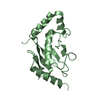
| ||||||||
| 3 | 
| ||||||||
| 4 | 
| ||||||||
| Unit cell |
|
- Components
Components
| #1: Protein | Mass: 18442.270 Da / Num. of mol.: 2 Source method: isolated from a genetically manipulated source Source: (gene. exp.)  Homo sapiens (human) / Gene: Ubc9 / Plasmid: pGEX6P / Production host: Homo sapiens (human) / Gene: Ubc9 / Plasmid: pGEX6P / Production host:  References: UniProt: P63279, Ligases; Forming carbon-nitrogen bonds; Acid-amino-acid ligases (peptide synthases) #2: Protein | Mass: 8677.913 Da / Num. of mol.: 2 / Fragment: SLD2, Ubiquitin-like domain, residues 339-412 Source method: isolated from a genetically manipulated source Source: (gene. exp.)   Sequence details | THIS COORDINATE | |
|---|
-Experimental details
-Experiment
| Experiment | Method:  X-RAY DIFFRACTION / Number of used crystals: 1 X-RAY DIFFRACTION / Number of used crystals: 1 |
|---|
- Sample preparation
Sample preparation
| Crystal | Density Matthews: 2.49 Å3/Da / Density % sol: 50.23 % |
|---|---|
| Crystal grow | Temperature: 277 K / Method: vapor diffusion, hanging drop / pH: 6 Details: 25% polyethylene glycol 1500, 0.1M SPG buffer : SPG buffer was prepared by mixing succinic acid, sodium dihydrogen phosphate, and glycine in the molar ratios 2:7:7, pH 6.0, VAPOR DIFFUSION, ...Details: 25% polyethylene glycol 1500, 0.1M SPG buffer : SPG buffer was prepared by mixing succinic acid, sodium dihydrogen phosphate, and glycine in the molar ratios 2:7:7, pH 6.0, VAPOR DIFFUSION, HANGING DROP, temperature 277K |
-Data collection
| Diffraction | Mean temperature: 100 K |
|---|---|
| Diffraction source | Source:  SYNCHROTRON / Site: SYNCHROTRON / Site:  Photon Factory Photon Factory  / Beamline: BL-17A / Wavelength: 1 Å / Beamline: BL-17A / Wavelength: 1 Å |
| Detector | Type: ADSC QUANTUM 270 / Detector: CCD / Date: Jan 22, 2009 |
| Radiation | Protocol: SINGLE WAVELENGTH / Monochromatic (M) / Laue (L): M / Scattering type: x-ray |
| Radiation wavelength | Wavelength: 1 Å / Relative weight: 1 |
| Reflection | Resolution: 2.58→46.4 Å / Num. obs: 13920 / % possible obs: 93.6 % / Redundancy: 3.4 % / Biso Wilson estimate: 38.93 Å2 / Rmerge(I) obs: 0.061 / Net I/σ(I): 18.2 / Num. measured all: 645440 |
| Reflection shell | Resolution: 2.58→2.69 Å / Redundancy: 2.6 % / Rmerge(I) obs: 0.196 / % possible all: 73.5 |
- Processing
Processing
| Software |
| ||||||||||||||||||||||||||||||||||||||||||||||||||||||||||||||||||||||
|---|---|---|---|---|---|---|---|---|---|---|---|---|---|---|---|---|---|---|---|---|---|---|---|---|---|---|---|---|---|---|---|---|---|---|---|---|---|---|---|---|---|---|---|---|---|---|---|---|---|---|---|---|---|---|---|---|---|---|---|---|---|---|---|---|---|---|---|---|---|---|---|
| Refinement | Method to determine structure:  MOLECULAR REPLACEMENT MOLECULAR REPLACEMENTStarting model: PDB entries; 1A3S and 3A4R Resolution: 2.7→46.366 Å / Occupancy max: 1 / Occupancy min: 0 / FOM work R set: 0.776 / SU ML: 0.41 / σ(F): 1.98 / Phase error: 29.46 / Stereochemistry target values: ML
| ||||||||||||||||||||||||||||||||||||||||||||||||||||||||||||||||||||||
| Solvent computation | Shrinkage radii: 0.9 Å / VDW probe radii: 1.11 Å / Solvent model: FLAT BULK SOLVENT MODEL / Bsol: 20.944 Å2 / ksol: 0.335 e/Å3 | ||||||||||||||||||||||||||||||||||||||||||||||||||||||||||||||||||||||
| Displacement parameters | Biso max: 98.02 Å2 / Biso mean: 42.69 Å2 / Biso min: 11.66 Å2
| ||||||||||||||||||||||||||||||||||||||||||||||||||||||||||||||||||||||
| Refinement step | Cycle: LAST / Resolution: 2.7→46.366 Å
| ||||||||||||||||||||||||||||||||||||||||||||||||||||||||||||||||||||||
| Refine LS restraints |
| ||||||||||||||||||||||||||||||||||||||||||||||||||||||||||||||||||||||
| LS refinement shell |
|
 Movie
Movie Controller
Controller




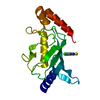
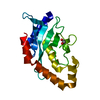
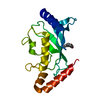
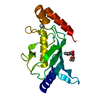
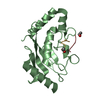
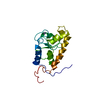

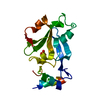

 PDBj
PDBj
















